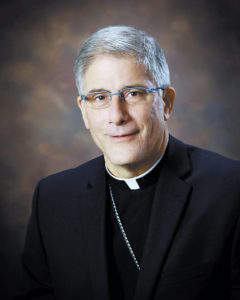
Bishop Kopacz
By Bishop Joseph Kopacz
I returned from my Holy Land pilgrimage, sponsored by the Knights and Dames of the Holy Sepulcher, on Friday night, Feb 16. As the cobwebs from jet lag after 15 hours of flying are gradually swept away by blessed sleep and home sweet home, I can see that the Scripture readings for the first Sunday of Lent are a bridge between my Holy Land experience and the beginning of this sacred season.
The theme of Baptism was foremost on this year’s first Sunday in Lent as we heard in the first letter of Peter reflecting back on the great flood in Noah’s time. “Noah and his family were saved through water. This prefigured baptism, which saves you now. It is not a removal of dirt from the body but an appeal to God for a clear conscience through the resurrection of Jesus Christ.” Immediately before Jesus was driven out into the desert by the Holy Spirit, last Sunday’s Gospel, he was baptized by John in the Jordan River and revealed as God’s beloved Son.
During the course of 40 days in the wilderness, in solitude and communion with his heavenly Father, yet not sheltered from the assaults of temptations, Jesus fortified his identity as God’s beloved Son. Upon leaving the desert, immediately he hit the ground in full stride, proclaiming the Kingdom of God and the call to reform our lives and believe in the Gospel, our Ash Wednesday ritual, sealed by our Amen.
One of the most poignant moments of the pilgrimage to the Holy Land was our gathering at the Jordan River. We are not talking about a Mississippi-sized river, but more of a large stream of water that flows of the Sea of Galilee in the North into the Dead Sea to the South. Yet, it has profound meaning for all Christians as the place where the public ministry of Jesus flowed from the heart of God. The story of Noah and the great flood is a powerful faith story, as we know, but we cannot locate these events in space and time. On the other hand, the Jordan river is real, the ministry of John the Baptist is historical, and Jesus is the one for whom John prepared the way.
Through the eyes of faith and the desire to renew our baptismal covenant in the death and resurrection of Jesus Christ, we pilgrims stood on the bank of the Jordan and professed our faith. The Rite of Sprinkling followed with the brown water from the river, heartfelt, but also squeamish over the possibility of swallowing any of it. All around us a steady stream of pilgrims came to renew their Baptism, or to be baptized for the first time in the flowing waters. A quick glance around the walkways and river banks revealed disciples of the Orthodox traditions, as well as those from the Evangelical and Baptist denominations who were standing in the river and celebrating full immersion. They were in the river, while we were at the river. A big physical difference, but in either ritual it is the faith that we have in the Lord Jesus and his call to live as his disciples that is the heart of the matter. Will it change our lives where we need it most once the water evaporates? This graced moment occurred approximately half way through the pilgrimage which began in Galilee at the Sea of Tiberius. From there we were able to launch out and visit Nazareth, the place of Mary’s birth and the site of Jesus’ hidden life before his public ministry.
Capernaum also was part of the northern circuit where we stood at the site of the synagogue where Jesus initiated his formal public ministry by preaching, teaching, driving out demons, healing Peter’s mother-in-law and forgiving the sins of the paralytic whose friends lowered him through the roof at Peter’s home across the street from the synagogue. This all occurred after Jesus announced the Kingdom and the call for repentance. Archaeological discoveries and excavated sites from the second half of the 20th century have authenticated the gospel accounts of the synagogue and home of Peter in Capernaum.
Back to the river. After the renewal of our baptismal covenant at the Jordan River, we turned our sights on Jerusalem and the final days of our Lord’s life. Today we know these days as Palm Sunday and Holy Week, leading to the Lord’s death and resurrection. This second half of the pilgrimage also included visits to Jericho and Bethany, the site of the community of Essenes at Qumran and the Dead Sea. The photos alone, hundreds and hundreds of them, some of which I tweeted after each day’s events, will provide many moments of reflection and edification for me during Lent.
With the Church and in our personal lives, the Lord calls each of us during this 40-day pilgrimage of Lent to turn away from sin and believe in the Gospel, to remember that we are dust and unto dust we have returned, and that in the end there are three things that remain, faith, hope and love, and the greatest of these is love. May our intentional Lenten prayer, fasting and almsgiving lead us to value the things that really matter in Christ Jesus, to discard those that don’t, and to know deep within that our citizenship is in heaven. We are God’s beloved children in Jesus Christ, and may we live in the full stride of the master.
